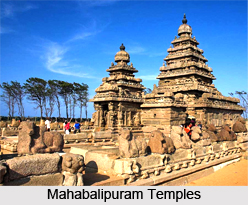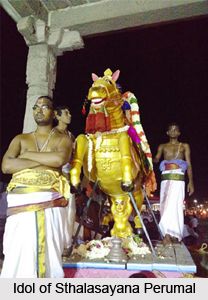 The Mamallapuram or Mahabalipuram Temples are several temples of enormous size, which were built by cutting huge boulders into exquisite carves and set against the background of unfathomable sky and vast sea. This was a concept of great Pallava Monarch Rajasimha, which was built during the period 830-1100 AD in the Pallava dynasty. Few of the great monuments of world stand here near the seashore. The freestanding monolithic temples are called `Rathas`. The cave temples are lavishly sculptured with the narration of the story of Arjuna obtaining the `Pasupata`. The temples with two towers, familiarly known as shore temples, also enhance the charm of this place.
The Mamallapuram or Mahabalipuram Temples are several temples of enormous size, which were built by cutting huge boulders into exquisite carves and set against the background of unfathomable sky and vast sea. This was a concept of great Pallava Monarch Rajasimha, which was built during the period 830-1100 AD in the Pallava dynasty. Few of the great monuments of world stand here near the seashore. The freestanding monolithic temples are called `Rathas`. The cave temples are lavishly sculptured with the narration of the story of Arjuna obtaining the `Pasupata`. The temples with two towers, familiarly known as shore temples, also enhance the charm of this place.
Mahabalipuram is located close to Chennai of Tamil Nadu on the shores of the Bay of Bengal, along the eastern coast of South India. The shore temples are also known as seven pagodas, among which six are submerged in the sea and only one has survived from the ravages of nature. There are forty monuments of different types in Mahabalipuram, which also includes an open-air bas-relief` that is the largest in the world. For centuries this place has been a large attraction to pilgrimages and even today it attracts the tourists of India and abroad in large numbers.
There are two low hills in Mahabalipuram, situated about 400 m from the sea which has eleven excavated temples on both sides, known as `Mandapas`. There is another unique type of temple standing nearby, called `Ratha`s , which are `cut out` of large rocks. There are total five Rathas and three big sculptures of Nandi (ox of Lord Shiva), Lion and an Elephant. On the top of the bigger hill, there is a structural temple and in a little distance `Vijaynagara Gopura` is situated.
THE FIVE RATHAS : The five Rathas comprise of the Dharmaraja, the Bhima, the Arjuna, the Draupadi and the Sahadeva. The Rathas are situated about two hundred metre south of the main hill and were designed out of smaller hill sloping down from the south. The biggest of the Rathas were the Dharmaraja, which was made from the largest part of the rock at the southernmost side. This follows in a descending order of height and to the direction of north the Bhima, the Arjuna and the Draupadi. A little to the west of Draupadi Ratha , Sahadeva Ratha was made out of a comparatively large rock. Immediately infront of the Draupadi,two smaller rocks were sculptured into an elephant and a lion. Behind the Draupadi and the Arjuna, Nandi is sculptured on a common base.
THE SHORE TEMPLE : The shore temple is the feast of vision to the spectators, which is situated at the very margin of Bay of Bengal in such a way that tidal waves sweeps away its walls. This is the reason why the sculptures of this temple have eroded most during the last thirteen century by saline water and high breeze. The shore temple is the most appealing in sense of aesthetic value. With the rising sun spreading its golden rays and white cloud moving across the azure sky, the tower look most fascinating.
 THE SHRINES IN THE SHORE TEMPLE : This temple is the most complex group of all the temples having two shrines placed one behind the other, one facing east and the other west and this two shrines are separated by a third shrine. The first two shrines are Saiva and the third is Visnava, with an image of Lord Anantasavi made of live rock. Here Vishnu lies on his serpent couch and known as Stalasayana Perumal. There is an open large court at the western end. There are `Vimanas` over the Saiva shrines but not on the Vaisnava shrine, it seems to have disappeared with time. This is one of the earliest structural temples in Tamil Nadu, built by Narasimha Varman II and Rajasimha.
THE SHRINES IN THE SHORE TEMPLE : This temple is the most complex group of all the temples having two shrines placed one behind the other, one facing east and the other west and this two shrines are separated by a third shrine. The first two shrines are Saiva and the third is Visnava, with an image of Lord Anantasavi made of live rock. Here Vishnu lies on his serpent couch and known as Stalasayana Perumal. There is an open large court at the western end. There are `Vimanas` over the Saiva shrines but not on the Vaisnava shrine, it seems to have disappeared with time. This is one of the earliest structural temples in Tamil Nadu, built by Narasimha Varman II and Rajasimha.
A little to south of the sancta, there is a majestic lion which carries a miniature of `Mahisasurmardini` carved inside a square cavity cut in the neck of the animal. Two attended deities or women are mounted on either side of the animal. A little north to this, a beautiful dear is carved on a platform, whose head is mutilated unfortunately. In between the lion and the dear a dwarf stands, whose legs are the only remnants now.
TEMPLE OF STHALASAYANA PERUMAL : It is situated to the north of the bigger hill. To the west of the five Rathas there are three more rathas, two of which are side by side. About 600m north of Mahabalipuram, Saluvankuppam is situated along the coast, where there are magnificent temples excavated. Very near to it `Tiger cave` is situated, which is a rock Mandapa and whose periphery is decorated with sculptures of tiger heads. Another structural temple, known as Mukunda Nayanar is situated two hundred metres away from sea, in between Mahabalipuram and Saluvankuppam.
Each one of this monuments, be it structural temple, excavated temple, cut-out temple, open air bas relief , Mandapas are very important in aspect to the sculpture of Pallava dynasty in South India. The celebrated open air bas relief of shore temple called as `Arjuna`s Penance` and the `Raths` are still the wonders to the visitors` eyes. Most of the monuments are of Pallava dynasty except the original Sthalasayana Perumal temple was constructed in Vijaynagar times and the Mandapas belong to Chola days.
This place is also a World Heritage Site marked by UNESCO.



















